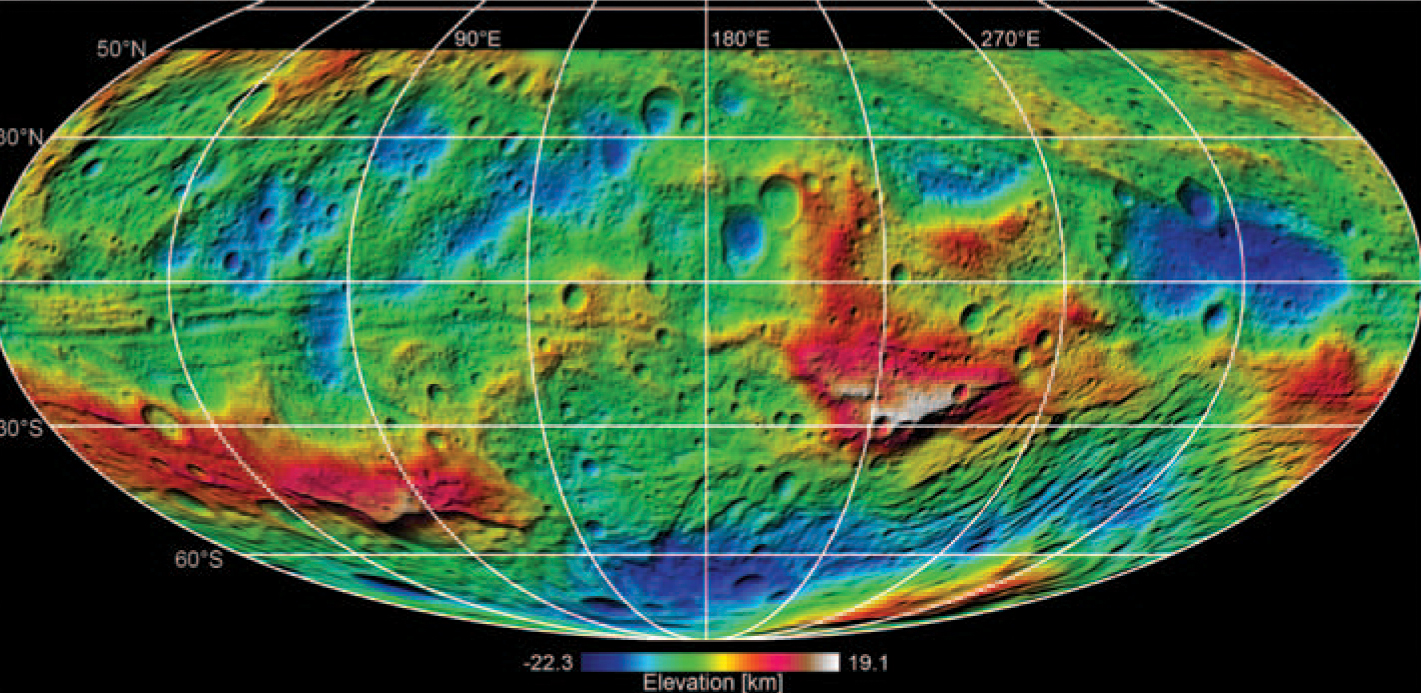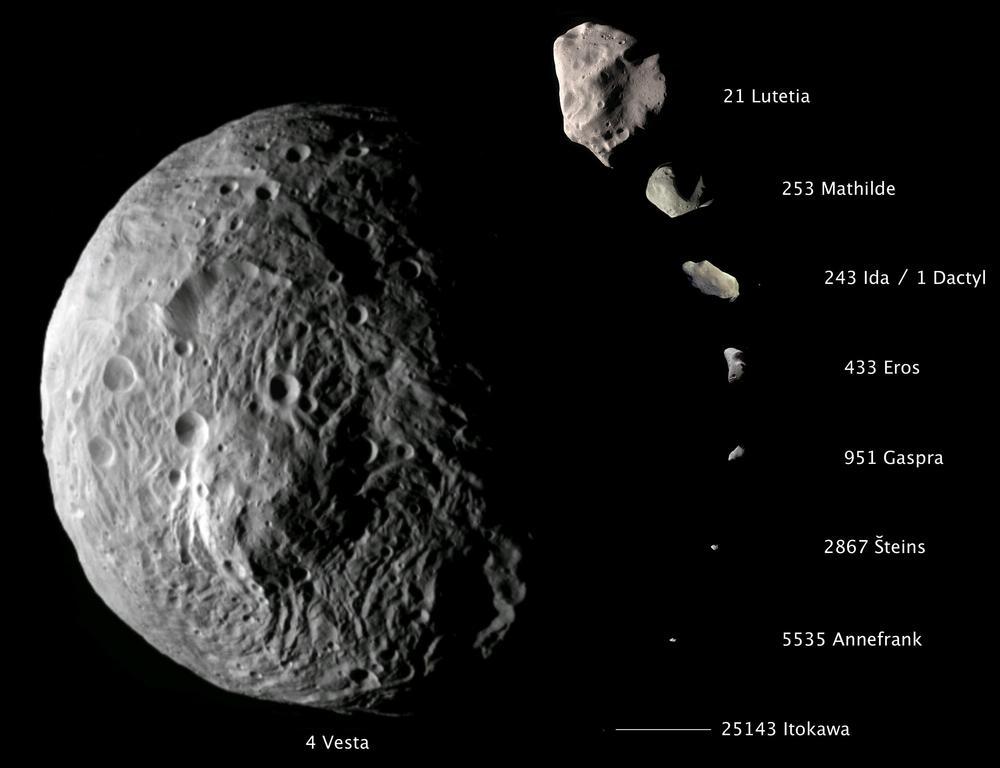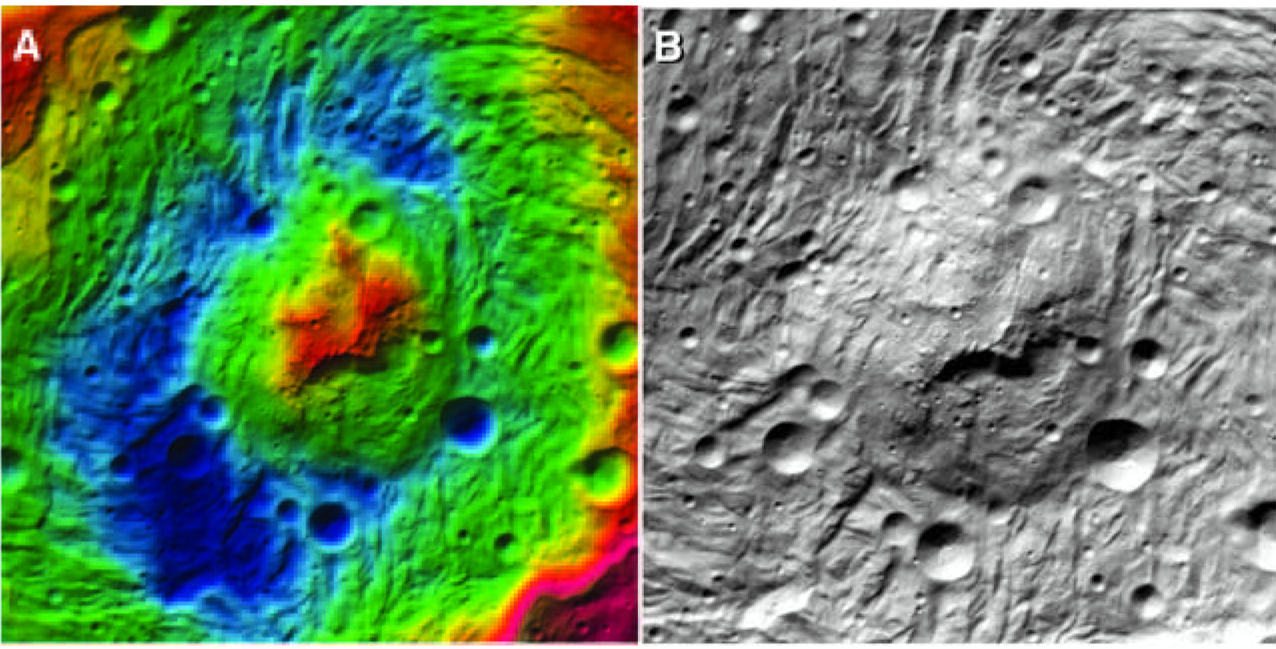
This story was updated at 3:15 p.m. EDT.
New observations from a NASA spacecraft show that the huge asteroid Vesta is a battered protoplanet left over from the solar system's early days, with a unique mix of characteristics unknown from any other space rock.
Scientists had thought that Vesta, the second-largest body in the main asteroid belt between Mars and Jupiter, probably started down a planet-forming path shortly after the solar system's birth. Data gathered by NASA's Dawn probe have now confirmed that suspicion, researchers announced in a raft of studies that came out today (May 10) in the journal Science.
"We now know that Vesta is the only intact, layered planetary building block surviving from the very earliest days of the solar system," Dawn deputy principal investigator Carol Raymond, of NASA's Jet Propulsion Laboratory in Pasadena, Calif., told reporters today.
The other objects like Vesta, researchers added, were probably incorporated into full-fledged planets or destroyed by collisions long ago. [Photos: Asteroid Vesta by Dawn Probe]
Some surprises
"Those studying meteorites that have fallen to Earth, many from Vesta, had produced a theory on the evolution of the solar system and what Vesta should be made of," said Dawn principal investigator Chris Russell of UCLA, lead author of one of the six new Science papers.
Get the Space.com Newsletter
Breaking space news, the latest updates on rocket launches, skywatching events and more!
"They were very, very right," Russell told SPACE.com via email. "This is good, because we can now use that model to understand more about the solar system."
But Dawn has also delivered some surprising new results. The gigantic Rheasilvia basin at Vesta's south pole, for example, apparently was created by a massive impact just 1 billion years ago or so — long after the solar system's collision-filled "shooting gallery" stage is thought to have ended.
"An age of about 1 billion years for Rheasilvia is unexpectedly young," Simone Marchi of the Southwest Research Institute in Boulder, Colo., lead author of another of the new papers, said in a statement. "This result has important implications for our understanding of the evolution of Vesta, its asteroid family and the inner main asteroid belt in general."
"We have just started exploring Vesta’s secrets, and I’m sure other intriguing results will come along shortly," Marchi added.

The protoplanet Vesta
With a diameter of about 330 miles (530 kilometers), Vesta is roughly as wide as the U.S. state of Arizona. In the main asteroid belt, only the dwarf planet Ceres is bigger.
The $466 million Dawn spacecraft arrived at the huge asteroid in July 2011 to help unlock its many secrets. One of the probe's main missions, researchers said, is to determine if Vesta is indeed a long-surviving protoplanet — a body left over from the solar system's first few million years, many of which later coalesced to form rocky planets such as Earth and Mars.
Scientists got this idea mainly by examining fallen howardite-eucrite-diogenite (or HED) meteorites, which are thought to come from Vesta. The new Dawn results strongly support the protoplanet notion — by confirming that Vesta is indeed the HED meteorites' parent body, for starters.
Moreover, the huge asteroid isn't just some chunk of uniform rock. Rather, it's now known to be a differentiated object with an iron core about 137 miles (220 km) wide. That's big enough, perhaps, to have once sustained a dynamo like the one that generates Earth's magnetic field, researchers said.
The team figured out the dimensions of Vesta's core in part by carefully tracking Dawn's movements through space, then using this information to calculate Vesta's mass, density and gravitational pull with unprecedented precision. [Video: Vesta Flyover in 3D]
Other Dawn data also back Vesta's protoplanet status. For instance, its surface composition implies a complex geological history that's more similar to that of terrestrial planets than other asteroids, researchers said. And Vesta boasts color variations unlike anything seen on an asteroid before, further suggesting that the massive object is something special.
"We now know that Vesta is large enough to have had its own internal geologic evolution and is not just a battered lump of rock," said Paul Schenk of the Lunar and Planetary Institute in Houston, lead author of another of the new studies.

Two gigantic (and recent) impacts
Vesta's surface is pocked with craters from countless collisions over the eons. Dawn's observations have allowed scientists to reconstruct the protoplanet's impact history by counting these craters, and noting how many impact features overlie others.
Researchers found a huge difference between Vesta's northern and southern halves. The northern part retains a record of some of the asteroid's earliest impacts, while the south was "reset" by two enormous collisions far more recently.
One of these smashups occurred about 2 billion years ago, creating a 249-mile-wide (400-km) basin called Veneneia. But Veneneia was mostly obliterated about 1 billion years ago by another impact, which created the 314-mile (505-km) Rheasilvia crater.
"This basin erased at least half the surface and messed up a lot of the rest of it," Schenk told SPACE.com via email.
The Rheasilvia impact also created strange circular troughs around Vesta's equator and raised a central peak more than twice as high as Mount Everest, Russell said. And it excavated approximately 250,000 cubic miles (1.04 million cubic km) of material, much of which was blasted into space.
"Two hundred and fifty thousand cubic miles is enough to fill the Grand Canyon about a thousand times over," said David O'Brien, a Dawn scientist based at the Planetary Science Institute in Tucson, Ariz. "So this is a very large volume of material."
Both giant craters were likely caused by asteroids between 25 and 36 miles (40 to 60 km) wide, Schenk said. And both impacts seem to have occurred surprisingly late, several billion years after the presumed end of the so-called Late Heavy Bombardment that blasted many craters into Earth's moon and other solar system bodies.
More discoveries to come
The new results are based on data that Dawn gathered during the early stages of its stay at Vesta. The spacecraft will continue studying the protoplanet until Aug. 26, so we should expect more discoveries from the mission, researchers said.
"We have not yet reported on the high-resolution measurements made at low altitudes," Russell said. "We will be searching for water, just like there have been water searches on the moon."
Further, Vesta's far northern reaches have been in shadow thus far, so Dawn has been unable to study large chunks of the protoplanet. But that will change before too long.
"Sunlight is moving northward on Vesta, and we will soon see the north pole regions," Russell said. "What could be there to complement what we see in the south?"
When Dawn finishes up at Vesta, it will start the long trek to the dwarf planet Ceres, which is roughly as wide as Texas. The probe is scheduled to reach the "queen of the asteroid belt" in February 2015 and embark upon a whole new round of discoveries.
"We expect that Ceres is a much wetter world" than Vesta, Russell said. But, he added, "we have no meteorites to help us here. Everything will be a surprise."
You can follow SPACE.com senior writer Mike Wall on Twitter: @michaeldwall. Follow SPACE.com for the latest in space science and exploration news on Twitter @Spacedotcom and on Facebook.
Join our Space Forums to keep talking space on the latest missions, night sky and more! And if you have a news tip, correction or comment, let us know at: community@space.com.

Michael Wall is a Senior Space Writer with Space.com and joined the team in 2010. He primarily covers exoplanets, spaceflight and military space, but has been known to dabble in the space art beat. His book about the search for alien life, "Out There," was published on Nov. 13, 2018. Before becoming a science writer, Michael worked as a herpetologist and wildlife biologist. He has a Ph.D. in evolutionary biology from the University of Sydney, Australia, a bachelor's degree from the University of Arizona, and a graduate certificate in science writing from the University of California, Santa Cruz. To find out what his latest project is, you can follow Michael on Twitter.









